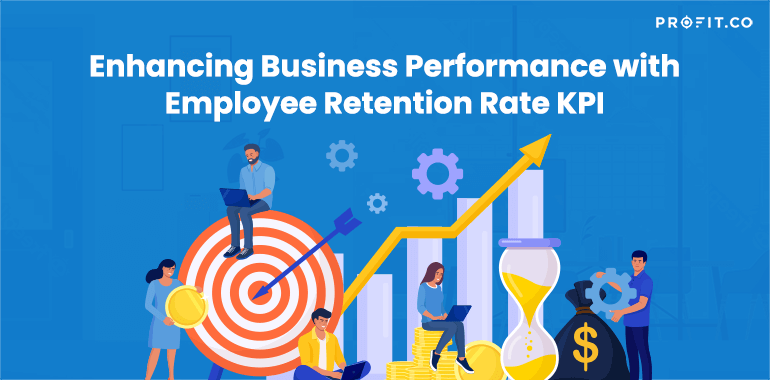In today’s dynamic business landscape, companies compete fiercely not just for market share but also for talent. Retaining top talent is paramount for continuous success, making the Employee Retention Rate (ERR) KPI an essential metric for every HR manager. But what is ERR, how do you calculate it, and why is it so pivotal? Let’s delve into this comprehensive guide and discover how this under-the-radar metric can dramatically elevate your business performance. If you are really looking for ways to explore the true potential of your team? then this blog is for you!
What is the Employee Retention Rate(ERR)?
Employee Retention Rate is a key HR metric that indicates the percentage of employees that a company has been able to retain over a specified period. A high ERR indicates that an organization is doing well in keeping its employees engaged and satisfied, while a low rate might signal underlying issues related to job satisfaction, company culture, or compensation.
The Internet is becoming the time square for the global village of tomorrow.
Validating ERR with a Forumula

Sort it Out with an Example:
Company XYZ is a growing company that started the year with 200 employees. Throughout the year, they hired 40 new employees. By the end of the year, they had 180 employees remaining. Calculate the Employee Retention Rate (ERR) for Company XYZ.
Initial Employee Count (January): Company XYZ starts the year with 200 employees.
End of Year Employee Count (December): By the end of December, the company has 180 employees remaining.
New Hires During the Year: Throughout the year, Company XYZ hired 40 new employees.
Now, let’s calculate the Employee Retention Rate (ERR) using the formula:
ERR = ((Number of employees at end of period − Number of employees hired during period) / Number of employees at the start of period) × 100
ERR = ((180 – 40) / 200) × 100
ERR = (140 / 200) × 100
ERR = 0.7 × 100
ERR = 70%
So, in this example, Company XYZ has an Employee Retention Rate (ERR) of 70%. This means that the company was able to retain 70% of its initial employees over the course of the year, taking into account the new hires that were brought in.
New to KPIs? Learn more with Profit.co
Why is Optimizing Employee Retention Rate Vital for Organizations?
A higher retention rate typically indicates that employees are satisfied and engaged with their jobs and the company. Conversely, a high turnover rate can be a red flag, signaling various issues within the organization. Here are some reasons why employee retention is vital
Cost Implications
Hiring and training a new employee can be 1.5 to 2 times more costly than retaining an existing one. From recruitment costs to training expenses, the financial implications are substantial.
Preserving Company Culture
Long-standing employees are custodians of the company culture. Their departure can dilute the essence of what makes the company unique.
Client Relationships
Employees with tenure often hold critical client relationships. Their exit can lead to a potential rupture in these relationships or a decline in service quality.
Knowledge Retention
Experienced employees possess invaluable institutional knowledge. Their departure can lead to a knowledge vacuum that’s hard to fill.
Strategies to Boost Employee Retention Rate
High turnover rates can lead to increased recruitment costs, loss of institutional knowledge, and a potential decrease in overall productivity. Here are some strategies to enhance the employee retention rate:
Engaging Work Environment
A positive, inclusive, and dynamic work culture promotes employee satisfaction.
Professional Development Opportunities
Regular training sessions, workshops, and growth opportunities can keep employees motivated.
Recognition and Rewards
Regularly acknowledging and rewarding employees’ contributions can foster loyalty.
Open Communication
An open-door policy, where employees feel heard and valued, can make a significant difference.
Using OKRs to Measure Employee Retention Rate
An improved organizational culture and better benefits are among the top factors that influence an employee’s decision to stay with a company. By targeting these areas, organizations can directly impact and improve their retention rate
Objective: Enhance the workplace environment
KR 1: Achieve an employee retention rate of atleast 93%
Initiative : Implement a “Stay Interview” program where HR meets with employees to discuss their career aspirations, gather feedback, and address potential concerns before they consider leaving.
KR 2: Increase employee satisfaction scores related to workplace environment from 80% to 90%
Initiative : Establish a “Workplace Enhancement Committee” comprising representatives from all departments to regularly review and recommend improvements to the physical workspace, office amenities, and work culture.
KR 3: Reduce the average response time to address workplace environment complaints from 48hrs to 24hrs.
Initiative: Introduce a dedicated “Employee Concerns Hotline” and support team trained to rapidly address and escalate any workplace environment complaints, ensuring swift resolution.
Concluding Thoughts
In conclusion, while the race to the top often has companies looking outward for opportunities and growth vectors, the real magic often happens internally. By understanding and leveraging the power of Employee Retention Rate, businesses can not only fortify their foundations but set themselves up for sustainable, long-term success. Are you ready to harness this untapped potential?

